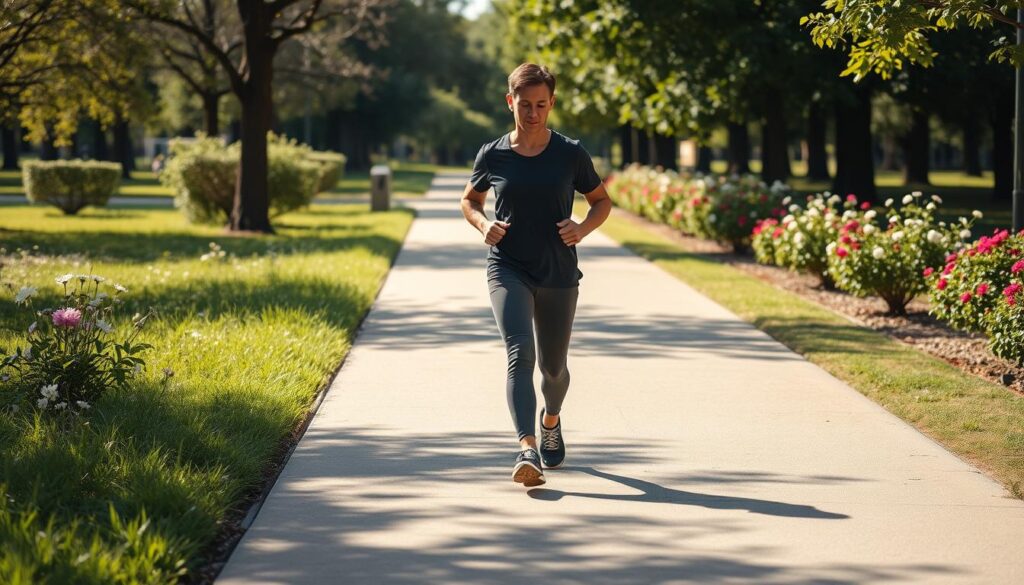Engaging in regular physical activity is crucial for maintaining overall health. One of the most accessible forms of exercise is walking, which offers numerous benefits for people of all ages and fitness levels.
Walking is a simple yet effective way to improve cardiovascular health and reduce the risk of chronic diseases. It can be done almost anywhere, making it an ideal form of exercise for busy lifestyles. By incorporating walking into your daily routine, you can experience a boost in energy levels and an overall improvement in physical and mental wellbeing.
Key Takeaways
- Regular walking strengthens the heart and improves cardiovascular health.
- It’s a low-risk exercise suitable for people of all ages.
- Walking can boost energy levels and improve mood.
- It’s a convenient form of exercise that requires minimal equipment.
- Incorporating walking into your daily routine can contribute to overall physical and mental wellbeing.
The Fundamentals of Walking as Exercise
As a simple yet effective form of physical activity, walking is accessible to everyone. It’s a form of exercise that requires no special equipment or training, making it an ideal activity for individuals of all ages and fitness levels.
Walking is free and easy to incorporate into daily life. A study by the University of Tennessee found that women who walked regularly had less body fat than those who didn’t walk. This finding underscores the potential of walking as a valuable component of a weight management strategy.

What Makes Walking an Ideal Form of Physical Activity
Walking stands out as an ideal form of physical activity for several reasons. Unlike high-intensity exercises that can strain joints and muscles, walking provides a gentle yet effective workout that most people can sustain for longer periods.
- It’s easy on the joints, reducing the risk of injury.
- Walking can be performed daily without the need for recovery time.
- The natural rhythm of walking makes it easier to maintain proper form.
- It’s a social activity that can be done with friends or family.
According to a quote by Dr. Kenneth Cooper, a pioneer in the field of preventive medicine, “Walking is the perfect exercise for people of all ages.” This sentiment is echoed by numerous health professionals who recommend walking as a primary form of exercise.
How Walking Differs from Other Forms of Exercise
While many forms of exercise offer various benefits, walking differs significantly from other activities in its impact level and overall effect on the body. For instance, walking generates less force on joints compared to running, making it a preferable option for those with joint issues.
When compared to resistance training, walking engages multiple muscle groups simultaneously while providing cardiovascular benefits. This holistic approach to fitness makes walking an efficient and effective form of physical activity.
Moreover, walking can be easily modified by changing pace, terrain, or adding weights to increase intensity, making it adaptable to different fitness goals. Whether you’re looking to improve cardiovascular health, boost heart rate, or simply enjoy the outdoors, walking is a versatile activity that can be tailored to your needs.
Understanding the Science Behind Walking Benefits
Walking, a fundamental form of physical activity, has been the subject of numerous studies highlighting its advantages. As a readily accessible form of exercise, walking offers a wide range of benefits that can be enjoyed by people of various ages and fitness levels. The science behind walking reveals its profound impact on our overall health and well-being.

How Walking Affects Your Body Systems
Regular walking has a significant impact on various body systems. It improves cardiovascular health by strengthening the heart and increasing blood flow efficiency. This form of physical activity also enhances the respiratory system by increasing lung capacity and promoting more efficient oxygen intake. Moreover, walking stimulates the musculoskeletal system, maintaining or improving muscle strength and flexibility.
Walking affects the body’s metabolic rate, influencing how we process energy. It helps regulate blood sugar levels by facilitating glucose uptake in the muscles. This is particularly important for individuals managing diabetes or those at risk of developing the condition. The consistent engagement in walking can lead to improved insulin sensitivity, a crucial factor in maintaining healthy blood sugar levels.
The Metabolic Impact of Regular Walking
The metabolic benefits of walking are multifaceted. Regular walking increases the body’s metabolic rate both during and after the activity, a phenomenon known as the “afterburn effect” or excess post-exercise oxygen consumption (EPOC). This means that the body continues to burn calories at a higher rate even after the walking session has ended.
Walking after meals can significantly improve blood sugar control. Studies have shown that light walking throughout the day is associated with improved postprandial blood sugar levels, with walking having a more substantial effect than standing. The consistent calorie burn from regular walking contributes to weight management by creating a caloric deficit when combined with proper nutrition.
Furthermore, walking helps improve mitochondrial function, making these cellular “powerhouses” more efficient at producing energy. Unlike high-intensity exercise that primarily burns carbohydrates, moderate-intensity walking utilizes a higher percentage of fat as fuel, especially during longer sessions. Regular walking can also help reduce visceral fat, the dangerous fat around organs, more effectively than some other forms of exercise.
Additionally, walking helps regulate appetite hormones like ghrelin and leptin, potentially reducing cravings and improving eating patterns. The metabolic benefits of walking extend beyond the activity itself, as it helps improve insulin sensitivity for up to 24 hours after a walking session.
Cardiovascular Benefits of Walking
The cardiovascular benefits of walking are multifaceted, improving heart health in various ways. Regular walking can strengthen the heart, reduce blood pressure, improve cholesterol levels, and enhance blood circulation. As a form of physical activity, walking is accessible to most people and can be incorporated into daily routines.

How Walking Strengthens Your Heart
Walking is an aerobic exercise that strengthens the heart by increasing heart rate and improving cardiovascular efficiency. Regular walking helps to increase cardiac output, allowing the heart to pump blood more effectively. This can lead to improved overall cardiovascular health and a reduced risk of heart disease.
As the heart becomes stronger, it becomes more efficient at pumping blood, which can lead to lower blood pressure and improved circulation. The calf muscles act as a “second heart” during walking, contracting and relaxing to pump blood back up to the heart against gravity, further enhancing cardiovascular function.
Walking for Reduced Blood Pressure
Regular walking can help reduce blood pressure by improving cardiovascular function and reducing vascular resistance. As walking strengthens the heart, it becomes more efficient at pumping blood, which can lead to lower blood pressure. Additionally, walking helps to improve blood vessel function, allowing them to dilate and constrict more effectively, further contributing to blood pressure reduction.
Lower blood pressure reduces the risk of cardiovascular diseases, including heart disease and stroke. By incorporating walking into their daily routine, individuals can take a proactive step towards managing their blood pressure and improving overall cardiovascular health.
Impact on Cholesterol Levels and Blood Circulation
Walking has a positive impact on cholesterol levels by helping to increase HDL (good) cholesterol while potentially lowering LDL (bad) cholesterol and triglycerides. Improved cholesterol profiles reduce the risk of cardiovascular diseases. Walking also stimulates blood circulation, particularly in the lower extremities, where circulation problems often begin.
- Regular walking improves cholesterol profiles.
- Walking stimulates blood circulation throughout the body.
- The calf muscles act as a “second heart” during walking, enhancing blood flow back to the heart.
- Improved circulation helps deliver oxygen and nutrients more efficiently to tissues.
- Walking reduces the risk of blood clots by improving circulation patterns.
By incorporating regular walking into their lifestyle, individuals can significantly improve their cardiovascular health, reducing the risk of heart disease and other cardiovascular risk factors.
Walking for Weight Management
Walking, as a form of physical activity, plays a crucial role in maintaining a healthy weight. It is an accessible and effective way to burn calories, which is essential for weight management. The actual number of calories burned during walking depends on several factors, including walking speed, distance covered, terrain, and the individual’s weight.

Calorie Burning Potential of Different Walking Styles
The calorie burning potential of walking can be influenced by the style or intensity of the walk. For instance, walking uphill or on an incline can significantly increase the number of calories burned compared to walking on a flat surface. Similarly, incorporating short bursts of brisk walking into one’s routine can enhance the overall calorie burn. The key is to vary the walking routine to keep challenging the body and maximizing the calorie burning potential.
Different walking styles can also impact the muscles engaged during the activity. For example, walking with a purposeful stride or incorporating arm movements can engage additional muscle groups, potentially increasing the energy expenditure. Understanding these nuances can help individuals tailor their walking routine to achieve their weight management goals more effectively.
Combining Walking with Healthy Eating for Weight Loss
While walking is an effective way to burn calories, combining it with healthy eating habits can significantly enhance weight loss efforts. Creating a caloric deficit by balancing the calories burned through walking with a mindful reduction in caloric intake is a sustainable approach to weight loss. This dual strategy not only aids in losing weight but also helps in maintaining the weight loss over time.
Walking before meals can help reduce appetite by temporarily suppressing hunger hormones, potentially leading to consuming fewer calories. Additionally, a consistent walking routine of 30-60 minutes most days of the week, combined with a modest reduction in caloric intake, can lead to 1-2 pounds of healthy weight loss per week. Establishing a routine of morning walking can also boost metabolism for several hours afterward, enhancing the calorie-burning potential throughout the day.
Moreover, the psychological benefits of walking, including stress reduction and mood improvement, can help reduce emotional eating patterns that often sabotage weight loss efforts. By incorporating walking into one’s lifestyle and combining it with healthy eating habits, individuals can achieve a more balanced and sustainable approach to weight management.
Bone and Joint Health Improvements
The act of walking is not just beneficial for cardiovascular health; it also plays a crucial role in maintaining strong bones and healthy joints. As a form of physical activity, walking is accessible to most people, regardless of age or fitness level, making it an ideal exercise for improving overall bone and joint health.

Strengthening Bones through Walking
Walking is a weight-bearing exercise that can help strengthen bones by stimulating bone growth and increasing bone density. This is particularly important for preventing osteoporosis, a condition characterized by weakened bones that are more susceptible to fractures. Regular walking can also help maintain bone health by promoting calcium deposition and reducing the risk of bone loss.
For individuals at risk of osteoporosis, incorporating walking into their daily routine can be a significant step towards maintaining strong bones. It’s essential to combine walking with other bone-strengthening activities and a balanced diet rich in calcium and vitamin D.
Supporting Joint Health and Reducing Pain
Walking can also benefit joint health by lubricating the joints and strengthening the surrounding muscles. This is particularly beneficial for individuals suffering from arthritis or other joint-related conditions. By improving circulation and reducing inflammation, walking can help alleviate pain and stiffness associated with these conditions.
The benefits of walking for joint health can be attributed to several factors:
- Dynamic loading during walking helps circulate synovial fluid, nourishing the cartilage and maintaining healthy joints.
- Regular walking strengthens the muscles around the joints, providing better support and stability.
- Walking improves joint range of motion, preventing stiffness and reducing the risk of further damage.
- The low-impact nature of walking makes it an ideal activity for individuals with joint pain or arthritis, as it puts relatively gentle pressure on the joints.
By incorporating walking into their lifestyle, individuals can experience significant improvements in both bone density and joint health, ultimately enhancing their overall health and well-being.
Mental Health and Mood Enhancement Through Walking
The benefits of walking extend far beyond physical health, significantly impacting mental well-being. Regular walking has been shown to have a positive effect on mental health by reducing symptoms of anxiety and depression, improving mood, and enhancing overall well-being.

Reducing Stress and Anxiety
Walking can be a powerful tool in managing stress and anxiety. The physical activity of walking helps to reduce stress hormones, such as cortisol, while also releasing endorphins, which are natural mood lifters. Regular brisk walking can lead to a significant reduction in anxiety symptoms, improving overall mental health.
- Reduces stress hormones like cortisol
- Releases endorphins, improving mood
- Enhances sleep quality, further reducing stress
Managing Depression
Regular walking can play a crucial role in managing depression. By incorporating physical activity into their routine, individuals can experience an improvement in depressive symptoms. Walking outdoors can be particularly beneficial, as it combines physical activity with exposure to natural light and environments, which can help alleviate symptoms of depression.
- Improves mood through the release of endorphins
- Enhances self-esteem through achievement and progress
- Provides opportunities for social interaction, reducing feelings of isolation
Improving Self-Esteem and Emotional Well-being
Walking not only improves physical health but also has a profound impact on self-esteem and emotional well-being. The sense of accomplishment from regular walking can boost self-confidence and self-efficacy, key components of healthy self-esteem. Additionally, the physical changes resulting from regular walking, such as improved posture and energy levels, can positively influence body image and self-perception.
- Provides a sense of accomplishment and progress
- Enhances self-confidence and self-efficacy
- Promotes positive body image and self-perception
To experience these mental health benefits, aim for at least 30 minutes of brisk walking or other moderate-intensity exercise three days a week. You can also break this down into shorter walks throughout the day, such as three 10-minute walks.
Cognitive Benefits and Brain Health
Walking, a simple yet powerful form of exercise, offers numerous benefits for brain health. Regular physical activity, such as walking, has been shown to have a significant impact on cognitive function and overall well-being.

Slowing Mental Decline
Engaging in regular walking can help slow down mental decline associated with aging. Studies have indicated that physical activity promotes cognitive health by enhancing blood flow to the brain, thereby supporting the health of brain cells.
A study from the University of Virginia Health System found that men between the ages of 71 and 93 who walked more than a quarter of a mile per day had half the incidence of dementia and Alzheimer’s disease than those who walked less. This suggests that even modest amounts of walking can significantly reduce the risk of cognitive decline.
Reducing the Risk of Alzheimer’s and Dementia
Research shows that regular walking can reduce the risk of Alzheimer’s disease and dementia by up to 50% in some populations. The mechanisms behind this protective effect are multifaceted, involving improved cerebral blood flow, reduced accumulation of beta-amyloid plaques, and anti-inflammatory effects.
- Walking helps clear metabolic waste products from the brain through the glymphatic system.
- The anti-inflammatory effects of walking may protect against neuroinflammation.
- Navigating different routes while walking provides mental exercise, building cognitive reserve.
- Walking in groups adds social engagement, further reducing dementia risk.
By incorporating walking into daily routines, individuals can take a proactive approach to maintaining brain health and reducing the risk of cognitive decline.
Blood Sugar Regulation and Diabetes Prevention
Walking is a simple yet effective way to regulate blood sugar and prevent diabetes. Regular physical activity, such as walking, has been shown to have a positive impact on blood sugar control. By incorporating walking into your daily routine, you can improve your overall health and reduce the risk of developing diabetes.

How Walking Affects Insulin Sensitivity
Regular walking can significantly improve insulin sensitivity, which is crucial for maintaining healthy blood sugar levels. When you engage in physical activity like walking, your muscles become more responsive to insulin, allowing glucose to enter the cells more efficiently. This reduces the amount of glucose in the bloodstream, thereby lowering blood sugar levels.
A study published in the Journal of Clinical Endocrinology and Metabolism found that regular walking improved insulin sensitivity in adults with prediabetes. The participants who walked regularly showed significant improvements in glucose uptake and insulin sensitivity compared to those who did not walk regularly.
Post-Meal Walking for Blood Sugar Control
Walking after meals, particularly after dinner, can have a significant impact on postprandial blood sugar levels. Research has shown that walking for just 10-15 minutes after meals can reduce post-meal blood sugar spikes by 22-33%. The greatest effect is seen after dinner, making it an ideal time to incorporate a short walk into your daily routine.
- Post-meal walking directs glucose to active muscles, reducing the amount of glucose in the bloodstream.
- Starting a walk within 30 minutes after finishing a meal provides the greatest blood sugar-lowering effect.
- Even short walks of 2-5 minutes can provide meaningful improvements in blood sugar control.
- For people with diabetes or prediabetes, post-meal walking can reduce the need for medication or insulin.
- Walking after high-carbohydrate meals provides the most significant benefit.
By incorporating regular walking into your lifestyle, you can improve your overall health, enhance blood sugar regulation, and reduce the risk of developing diabetes. Whether it’s a short walk after meals or a longer, more leisurely stroll, every step counts towards better health.
Muscle Strengthening and Toning Through Walking
Walking is a simple yet effective way to strengthen and tone muscles throughout the body. This low-impact physical activity engages multiple muscle groups, improving overall muscle strength and endurance.
Muscles Engaged During Walking
When you walk, various muscles are activated to support movement and maintain posture. The primary muscles engaged include those in the legs, such as the quadriceps, hamstrings, and calf muscles. Additionally, walking involves the activation of core muscles, including the abdominals and lower back muscles, which help stabilize the body during each step.
The arm muscles are also engaged, particularly if you incorporate arm pumping or swinging into your walking routine. This not only enhances the overall exercise experience but also contributes to toning the upper body.
- The quadriceps and hamstrings work together to control the movement of the legs.
- Calf muscles are responsible for the heel-to-toe rolling motion.
- Core muscles maintain posture and stability.
- Arm muscles are engaged through pumping or swinging actions.
Techniques to Maximize Muscle Benefits While Walking
To maximize the muscle strengthening and toning benefits of walking, several techniques can be employed. Incorporating hills or inclines into your walking route can significantly increase muscle activation, particularly in the glutes and calves.
Adding intervals of faster walking or power walking with exaggerated arm movements can enhance muscle engagement throughout the body. Maintaining proper posture by keeping your head up, shoulders back, and core engaged is also crucial for maximizing muscle activation.
- Incorporate hills or inclines to boost glute and calf activation.
- Use intervals of faster walking or power walking.
- Maintain proper posture to engage core and upper body muscles.
- Consider using walking poles for added upper body engagement.
- Add resistance with ankle weights or a weighted vest gradually.
By incorporating these techniques into your walking routine, you can enhance the muscle strengthening and toning benefits, leading to improved overall fitness and health.
Immune System Support and Disease Prevention
Regular walking is a simple yet effective way to boost your immune system and reduce the risk of various diseases. Engaging in physical activity like walking can have a significant impact on overall health, contributing to a stronger immune system and a lower risk of chronic conditions.
Walking’s Impact on Immune Function
Walking has been shown to have a positive effect on immune function. Regular physical activity can help in the production of white blood cells, which are vital for fighting off infections. According to a study published in the Journal of Applied Physiology, walking can enhance the circulation of immune cells, thereby improving the body’s response to pathogens.
The anti-inflammatory effects of walking are also noteworthy. By reducing chronic inflammation, walking can help in managing conditions like rheumatoid arthritis and other autoimmune disorders. As noted by a researcher, “Exercise is a powerful tool in the prevention and treatment of many diseases, and walking is one of the most accessible forms of exercise.”
Reduced Risk of Various Diseases Through Regular Walking
Regular walking is associated with a reduced risk of various diseases. The data indicates that walking can lower the risk of coronary heart disease by 20-30%, with benefits observed even at modest levels of walking. Furthermore, walking for 30 minutes daily is linked to a 20-40% lower risk of stroke, with faster walking paces showing greater protective effects.
Walking also appears to reduce the risk of certain cancers, particularly colon, breast, and endometrial cancers, with risk reductions of 20-30% for those who walk regularly. Additionally, the improved metabolism and digestive function associated with walking may reduce the risk of gallstones and other digestive disorders.
As physical activity, walking contributes to overall health and can play a role in reducing the risk of chronic diseases. Incorporating walking into your daily routine can be a significant step towards a healthier lifestyle.
Sleep Quality Improvement
Walking is a simple yet effective way to enhance sleep quality and overall well-being. Regular physical activity, such as walking, has been consistently shown to have a positive impact on various aspects of health, including sleep. By incorporating walking into your daily routine, you can potentially improve your sleep quality and overall health.
The Connection Between Walking and Better Sleep
Research has demonstrated that there is a significant connection between regular walking and improved sleep quality. Studies have found that women aged 50 to 75 who took one-hour morning walks were more likely to have less insomnia than those who didn’t walk. Walking helps in several ways: it resets the circadian rhythm by exposing the body to natural light, promotes relaxation, and aids in the natural drop in body temperature that signals sleep readiness.
Moreover, walking outdoors during daylight hours provides the additional benefit of vitamin D production, which plays a role in sleep regulation. For individuals with sleep maintenance insomnia, morning walks have shown the greatest benefit in improving sleep continuity. Brief “mini-walks” of 5-10 minutes throughout the day may also provide cumulative benefits for sleep quality.
Optimal Walking Times for Sleep Enhancement
The timing of walks can significantly impact their effectiveness in enhancing sleep quality. Morning walks, particularly those taken outdoors, can help reset the body’s internal clock by exposing it to natural light. This can lead to improved sleep quality the following night. For those struggling with falling asleep, an evening walk 1-2 hours before bedtime can promote relaxation and help reduce sleep onset latency.
Afternoon walks, especially between 2-4 PM, can help regulate the natural afternoon energy dip without interfering with nighttime sleep patterns. Consistency in walking times is also crucial, as regular physical activity at predictable times helps stabilize circadian rhythms. For shift workers, walking shortly after waking can help establish a healthy sleep-wake pattern, regardless of the time of day.
- Morning walks can improve sleep quality by resetting the circadian rhythm.
- Evening walks can promote relaxation and reduce sleep onset latency.
- Afternoon walks can help regulate the natural energy dip without affecting nighttime sleep.
- Consistency in walking times is key to stabilizing circadian rhythms.
Energy Levels and Fatigue Reduction
Feeling tired? A brisk walk can be just what you need to revitalize your body and mind. Walking is a natural energy booster that not only combats fatigue but also enhances overall physical and mental well-being. Unlike other forms of exercise that might leave you feeling drained, walking is a low-impact activity that can be adapted to various fitness levels.
How Walking Boosts Energy Throughout the Day
Walking increases oxygen flow through the body, which can lead to higher energy levels. It also stimulates the release of hormones like epinephrine and norepinephrine, which play a crucial role in regulating the central nervous system and elevating energy. Over time, regular walking can decrease levels of cortisol, a stress hormone that can contribute to feelings of fatigue.
A 10-minute brisk walk can increase energy levels for up to two hours, comparable to the effects of a cup of coffee but without the potential jitters or anxiety. This makes walking an excellent alternative to caffeine for those looking to reduce their caffeine intake.
- Walking stimulates blood flow and oxygen delivery throughout the body, addressing the root causes of fatigue.
- Morning walks can help establish healthy cortisol patterns, potentially reducing the need for afternoon caffeine.
- The endorphin release triggered by walking creates a natural, pleasant energy boost.
Walking as an Alternative to Caffeine for Energy
Unlike caffeine, which can lead to energy crashes and disrupted sleep patterns, walking provides a sustained energy boost without negative side effects. Walking breaks during periods of mental fatigue have been shown to restore attention and focus more effectively than caffeine consumption.
Moreover, walking outdoors provides exposure to natural light, which helps regulate melatonin production and circadian rhythms more effectively than artificial stimulants like caffeine. This natural approach to energy enhancement not only boosts physical energy but also supports mental well-being.
By incorporating walking into your daily routine, you can experience a natural energy boost that lasts throughout the day. Whether it’s a morning walk to start your day or a mid-day stroll to refresh your mind, walking is a simple yet effective way to combat fatigue and enhance your overall quality of life.
Longevity and Healthy Aging Benefits of Walking
Regular walking is a simple yet powerful tool for enhancing longevity and promoting healthy aging. As a form of physical activity, walking is accessible to people of all ages and fitness levels, making it an ideal activity for those looking to improve their overall health and extend their life.
Research has shown that individuals who engage in regular walking in their fifties and sixties are significantly less likely to die over the next eight years compared to their non-walking counterparts. Specifically, a study found that regular walkers in this age group were 35% less likely to die, with the benefit increasing to 45% for those with underlying health conditions.
Walking Habits in Blue Zones and Long-Lived Populations
The Blue Zones are regions around the world where people live longer and healthier lives. One common trait among these populations is their regular engagement in physical activity, such as walking. In these areas, walking is not just a form of exercise but a way of life, integrated into daily routines.
- Walking is a primary mode of transportation, contributing to overall physical activity levels.
- Regular walking helps maintain muscle mass and strength, reducing the risk of frailty.
- The cardiovascular benefits of walking directly address leading causes of death worldwide.
How Walking Contributes to Extended Lifespan
Walking appears to directly influence various factors associated with aging and longevity. For instance, regular walkers tend to have longer telomeres, the protective caps on DNA that shorten with age. This suggests that walking can make individuals biologically younger.
Furthermore, physical activity like walking helps regulate inflammation, a key driver of many age-related diseases. It also supports immune function, reducing susceptibility to infectious diseases that pose greater risks to older adults.
- Regular walking reduces the risk of chronic diseases, such as heart disease and diabetes.
- It improves mental health by reducing the risk of depression and social isolation.
- The cognitive benefits of walking may help maintain independence longer.
In conclusion, incorporating walking into one’s lifestyle can have a profound impact on health and longevity. By understanding the benefits and adopting regular walking habits, individuals can take a significant step towards a longer and healthier life.
Creative Thinking and Productivity Enhancement
Walking has been recognized as a catalyst for enhancing creativity and productivity in various settings. By incorporating physical activity into daily routines, individuals can experience a significant boost in their ability to think creatively and tackle complex problems.
Research has shown that walking can have a profound impact on cognitive function. It allows the mind to relax, fostering a free flow of ideas and enhancing creative thinking. This is particularly true when walking outdoors, as the natural environment can further stimulate the mind.
Walking for Problem-Solving and Idea Generation
One of the key benefits of walking is its ability to aid in problem-solving and idea generation. By engaging in regular physical activity, individuals can improve their cognitive flexibility, making it easier to approach problems from different angles.
- Walking can help clear the mind, allowing for a more focused approach to complex issues.
- The relaxed state induced by walking can facilitate the generation of new ideas.
- Outdoor walking, in particular, can stimulate creativity by exposing individuals to new environments.
Walking Meetings and Productivity Benefits
Walking meetings have gained popularity as a means to combine work and physical activity. These meetings not only promote health but also enhance productivity and foster a more collaborative work environment.
The benefits of walking meetings include:
- Increased meeting productivity by up to 10% due to reduced sitting time and enhanced cognitive function.
- More open communication among participants, as the informal setting reduces hierarchical barriers.
- More concise discussions with fewer distractions, leading to more efficient use of meeting time.
- Improved collaboration and reduced interpersonal tensions due to the shared experience of walking.
Companies like Google, Facebook, and LinkedIn have implemented walking meetings, reporting improvements in both employee satisfaction and meeting outcomes. By incorporating walking into their work routines, these companies have seen a positive impact on energy levels and overall productivity.
Getting Started with a Walking Routine
As you consider incorporating walking into your daily routine, it’s essential to understand the basics of getting started. Walking is a form of physical activity that offers numerous health benefits, from improving cardiovascular health to boosting mental wellbeing. By starting a walking routine, you’re taking a significant step towards a healthier lifestyle.
Essential Equipment and Proper Walking Form
Before you begin, it’s crucial to have the right equipment and understand the proper walking form. Wear sturdy shoes with good heel and arch support to prevent discomfort and potential injuries. Comfortable, loose clothing is also recommended to ensure a pleasant walking experience. Additionally, consider wearing reflective clothing or lights if you plan to walk during early morning or evening hours when visibility is low.
Maintaining proper walking form is equally important. Keep your posture straight, engage your core, and land midfoot or forefoot when you step. This helps in reducing the impact on your joints and makes your walking more efficient.
Creating a Progressive Walking Plan for Beginners
For those new to walking as a form of exercise, starting slow and gradually increasing your pace and distance is key. Begin with short walks of about 10-15 minutes and gradually increase the duration as your fitness level improves. It’s also beneficial to vary your route to keep the walks interesting and prevent boredom.
Setting realistic goals and tracking your progress can also enhance your walking routine. Consider using a pedometer or a fitness app to monitor your steps and time spent walking. This can help motivate you to maintain and improve your walking habit.
Safety Tips and Considerations for Walking
Safety should always be a top priority when walking, especially if you’re walking alone or at night. Always choose well-lit areas and stay alert to your surroundings. Avoid using headphones or keep the volume low so you can hear potential hazards. It’s also a good idea to let someone know your planned route and estimated return time.
- Stay hydrated by drinking water before, during (for longer walks), and after your walking session.
- Protect your skin with sunscreen, even on cloudy days, and wear a hat and sunglasses for additional protection.
- Check weather conditions before heading out and dress appropriately.
- Practice proper road safety by walking against traffic if no sidewalk is available.
By following these tips and being mindful of your surroundings, you can enjoy a safe and beneficial walking routine. Walking is a simple yet effective form of physical activity that can significantly enhance your overall health and wellbeing.
Conclusion: Incorporating Walking into Your Lifestyle for Optimal Health
By making walking a part of your daily routine, you can take a significant step towards achieving optimal health. Walking represents one of the most accessible and effective forms of physical activity available, with benefits spanning cardiovascular health, weight management, mental wellbeing, and disease prevention.
The cumulative research on walking demonstrates that even modest amounts—as little as 30 minutes daily—can significantly reduce the risk of major diseases and potentially add years to your life. Unlike many health interventions that require significant lifestyle changes, walking can be seamlessly incorporated into existing routines through simple adjustments like parking farther away, taking the stairs, or walking during phone calls.
The versatility of walking allows for customization based on individual needs, abilities, and preferences, making it sustainable for long-term health improvement. It offers a rare combination of immediate benefits (improved mood, energy, and cognition) and long-term health protection, providing both instant gratification and lasting motivation.
For those currently inactive, walking represents the ideal gateway to a more active lifestyle, with a low barrier to entry and minimal risk of injury compared to more intense forms of exercise. The social nature of walking can strengthen relationships and build community connections while simultaneously improving physical health, addressing multiple dimensions of wellbeing.
As we face increasing rates of chronic disease and an aging population, walking stands out as a simple, cost-effective public health strategy with the potential to transform individual and community health outcomes. By incorporating walking into your daily routine, you can take control of your health and wellbeing, reaping the rewards of this simple yet powerful form of physical activity.
